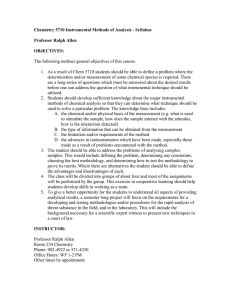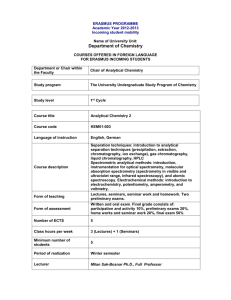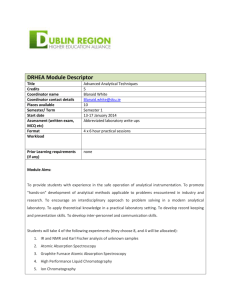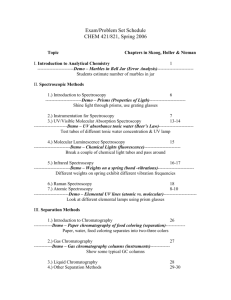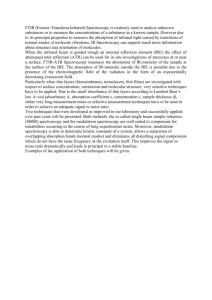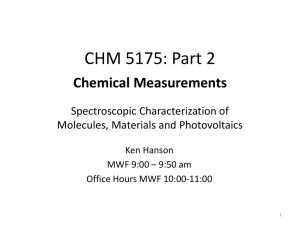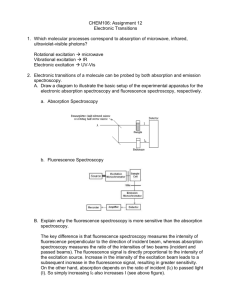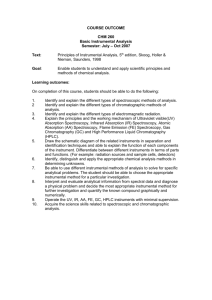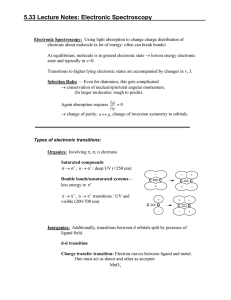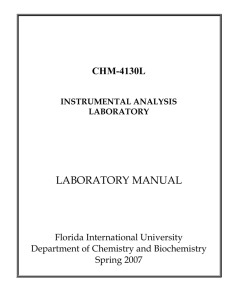SylCHEM466
advertisement
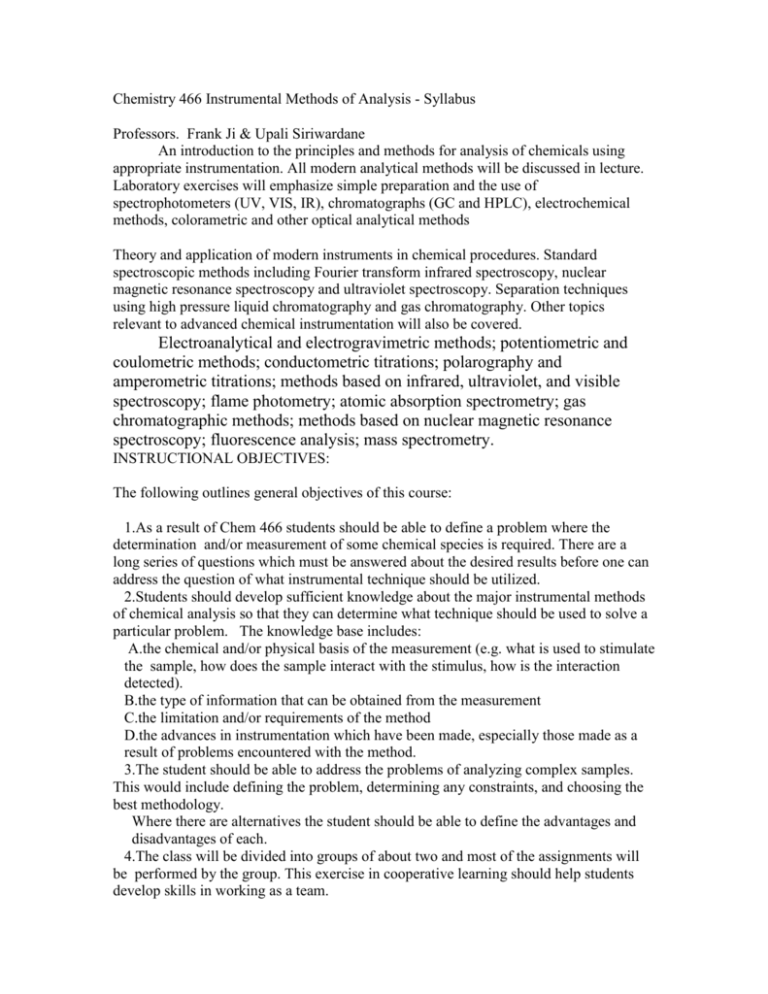
Chemistry 466 Instrumental Methods of Analysis - Syllabus Professors. Frank Ji & Upali Siriwardane An introduction to the principles and methods for analysis of chemicals using appropriate instrumentation. All modern analytical methods will be discussed in lecture. Laboratory exercises will emphasize simple preparation and the use of spectrophotometers (UV, VIS, IR), chromatographs (GC and HPLC), electrochemical methods, colorametric and other optical analytical methods Theory and application of modern instruments in chemical procedures. Standard spectroscopic methods including Fourier transform infrared spectroscopy, nuclear magnetic resonance spectroscopy and ultraviolet spectroscopy. Separation techniques using high pressure liquid chromatography and gas chromatography. Other topics relevant to advanced chemical instrumentation will also be covered. Electroanalytical and electrogravimetric methods; potentiometric and coulometric methods; conductometric titrations; polarography and amperometric titrations; methods based on infrared, ultraviolet, and visible spectroscopy; flame photometry; atomic absorption spectrometry; gas chromatographic methods; methods based on nuclear magnetic resonance spectroscopy; fluorescence analysis; mass spectrometry. INSTRUCTIONAL OBJECTIVES: The following outlines general objectives of this course: 1.As a result of Chem 466 students should be able to define a problem where the determination and/or measurement of some chemical species is required. There are a long series of questions which must be answered about the desired results before one can address the question of what instrumental technique should be utilized. 2.Students should develop sufficient knowledge about the major instrumental methods of chemical analysis so that they can determine what technique should be used to solve a particular problem. The knowledge base includes: A.the chemical and/or physical basis of the measurement (e.g. what is used to stimulate the sample, how does the sample interact with the stimulus, how is the interaction detected). B.the type of information that can be obtained from the measurement C.the limitation and/or requirements of the method D.the advances in instrumentation which have been made, especially those made as a result of problems encountered with the method. 3.The student should be able to address the problems of analyzing complex samples. This would include defining the problem, determining any constraints, and choosing the best methodology. Where there are alternatives the student should be able to define the advantages and disadvantages of each. 4.The class will be divided into groups of about two and most of the assignments will be performed by the group. This exercise in cooperative learning should help students develop skills in working as a team. 5.To give a better opportunity for the students to understand all aspects of operating an analytical laboratory, a quarter long project will focus on the requirements for a forensic laboratory involved in a high profile international case. INSTRUCTORS: TEXTBOOK: Analysis, 7th ed, Willard, Merritt, Dean, Settle, will be of value as a reference (many will be on reserve in library). GRADING: Group Presentations 40% Final Exam 20% Group Project 30% Participation 10% GROUP PROJECT: Any analytical approach requires that the problem be defined before making decisions about what type of instrumentation to utilize. The class will be divided into teams that will work together to define an analytical problem and develop a proposal for the analysis. There will be oral and written presentations as well as periodic progress reports. GROUP PRESENTATIONS: In an effort to be sure that each person is developing an understanding of a technique or the analytical approach, each group is expected to meet regularly to discuss and prepare for specific topics which they will be expected to present in class. These topics are specified below and will be used to supplement presentations made by the instructor. It is expected that there will be class discussions on the topics so even the groups not actually making presentations are expected to have investigated the topic and thus be able to contribute to the discussions. In the following schedule some of the specific topics that will be assigned are numbered sequentially for reference. PowerPoint presentations on some of these topics are available on the class web site. TENTATIVE SCHEDULE: I.Understanding the problem: the analytical approach A.knowing the questions to ask and recognizing connections B.recognizing strengths and weaknesses of the technique (what results are expected and where are the errors) C.knowing statistics is essential for interpretation D.general philosophy in instrument design E.special problems with analysis within the criminal justice system F.issues of quality assurance and quality control II.Molecular spectroscopy A.what are the samples and what results are expected B.infrared spectroscopy - most qualitative 1.what are the interactions with molecules absorption scattering 2.means of excitation (light sources) 3.separation of spectrum (wavelength dispersion, time resolution) 4.detection of the signal (heat, differential detection) 5.interpretation of spectrum (qualitative, mixtures, resolution) 6.advantages of Fourier Transform (FTIR) C.UV-Visible - more qualitative. emission absorption fluorescence photoacoustic 7.excitation sources (lasers, time resolution) 8.wavelength dispersion (gratings, prisms, interference filters, laser, placement of sample relative to dispersion, resolution) 9.detection of signal (photocells, photomultipliers, diode arrays, sensitivity and S/N) 10.interpretation (quantification, mixtures, absorption vs. fluorescence and the use of time, photoacoustic, fluorescent tags) D.mass spectroscopy 11.making the gaseous molecule into an ion (electron impact, chemical ionization) 12.making liquids and solids into ions (electrospray, electrical discharge, laser desorption, fast atom bombardment) 13.separation of ions on basis of mass to charge ratio magnetic time of flight electric quadrupole 14.resolution, time and multiple separations 15.detection and interpretation (how this is linked to excitation) E.Nuclear Magnetic Resonance - the dramatic changes that resulted from changing the analytical concept 16.isotopes (what has nuclear spin?) 17.spin gymnastics 18.spin gymnastics (timing) F.Immunoassays and DNA techniques III.Elemental analysis A.mass spectrometry (electrical discharges) B.atomic spectroscopy atomic absorption atomic emission atomic fluorescence 19.excitation and getting sample into gas phase (flames, electrical discharges, plasmas) 20.wavelength separation and resolution (dependence on technique) 21.detection of radiation (simultaneous/scanning, signal noise) 22.interpretation (errors due to molecular and ionic species, matrix effects, other interferences) C.X-ray analysis and electron spectroscopy (surface analysis) 23.electron excitation vs. fluorescence (sample size) 24.wavelength vs. energy dispersion 25.detection (ionization, health effects) 26.interpretation (resolution, competing processes, matrix effects, imaging) 27.surface analysis 28.electron spectroscopy D.neutron activation analysis (great accuracy but limited applicability) IV.Separation techniques (chromatography) 29.gas chromatography, liquid chromatography, supercritical fluids 30.importance of column technology (packing, capillaries) 31.separation based on increasing number of factors (volatility, solubility, interactions with stationary phase, size, electrical field) 32.detection: simple vs. specific (gas and liquid) 33.detection as a means of further analysis (use of tags and coupling to IR and MS) 34.electrophoresis (plates and capillary) and use with DNA analysis
